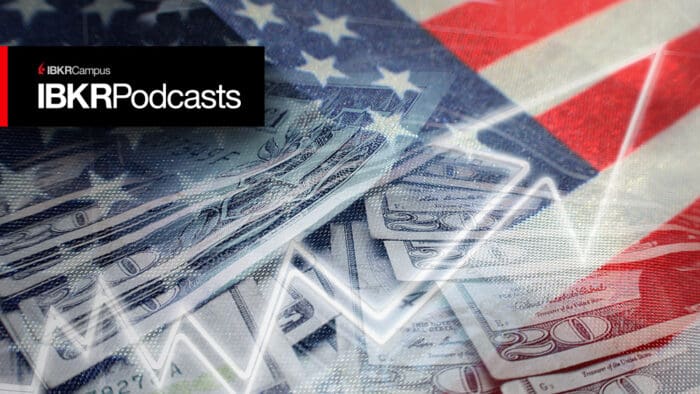Is the ongoing strength in the US labor market likely to cause the Federal Reserve to rethink at least the timing of when and by how much they could ease monetary policy?
Summary – IBKR Podcasts Ep. 149
The following is a summary of a live audio recording and may contain errors in spelling or grammar. Although IBKR has edited for clarity no material changes have been made.
Andrew Wilkinson
Welcome to this week’s Economic Podcast from Interactive Brokers. Joining me to discuss US economics this week, Steve Sosnick.
Steve Sosnick
Hello Andrew.
Andrew Wilkinson
Chief Strategist and Senior Economist, Jose Torres. Welcome Jose.
Jose Torres
Thank you, Andrew. Great to be here.
Andrew Wilkinson
Well, U.S. economy wise, I’m going to say we’re in a funny place, caught between yet another robust employment report for March. And then this week’s Consumer Price Index reports.
So let’s get your take on the Nonfarm payroll reading, Jose, and then we’ll assess how the money market is responding to where it sees the Federal Reserve heading in 2024. So Jose, go ahead, give us your run down and behind the scenes look at the March jobs picture.
Jose Torres
Sure. So, headline growth is really strong. Above 300,000. Most of the sectors added jobs. However, we did have a non-cyclical tilt once again with government, education and health services comprising a large share of employment gains last month.
Wage gains were very strong. 0.3% year over year. 4.1% still shows that the Fed is not there at their 2% inflation target if workers are getting 4.1% compensation increases year over year.
We saw some benefits from immigration and labor force participation. That increased, which is a favorable dynamic on the disinflationary side. Overall strong report.
As far as what it means for the Fed, the Fed has projected slower job growth at this point in the tightening cycle. And what this report did, and we’ll be waiting to see what happens with CPI, but now we’re incrementally delaying the Feds first cut.
As of right now, the odds for June are below 50% for a cut, so the favorite is for a move in July. If we continue to get hot data, if oil prices continue to increase, there’s an expectation that that will get delayed further. We’re also seeing an interesting development at the Fed, with some dissidents within some of the governors, as well as some of the presidents. Some of them are saying we’re only going to cut once, fourth quarter, some are saying we’re not going to cut at all, so there is a little bit of a shift in opinion across the governors, the chair, as well as the regional presidents.
Andrew Wilkinson
So Steve, you’ve been writing about this at length recently. Let’s ask you that question directly. Why exactly do we need rate cuts?
Steve Sosnick
On the surface, it’s not clear that we do. I’d like Jose either to agree or disagree in a minute. We think about it this way. The Fed has a dual mandate of stable prices and full employment. Well, we’ve checked the full employment box. We’ve been checking the full employment box for quite some time. And as Jose noted, we’re actually so strong on employment, still, that it adds to the pressures on stable prices, which is the leg of the stool that that still needs a lot of attention.
There’s sort of a third leg of the stool that isn’t really mentioned and that is stability and soundness of the financial system. But again, I see little out there that tells us that there’s any troubles in that regard.
So one of a couple of things happened. Maybe the Fed knows of stresses that we don’t. I’m not going to go down that road because that’s conspiracy theory thinking and I don’t want to do that. Or, more likely, in an election year, I think Powell has got us locked in on the idea of potential cuts and does not want to take that optionality off the table. Because if he has to take it off the table, then put it back on the table, that’s problematic in election year. It looks like he’s leaning one way or the other. In this case, he gets to stick to that narrative.
I find myself more in the camp of, let’s say, Fed presidents Bostic or Cook or Kashkari, who are sort of in the 0 to 1 camp. You can argue that we may want to do it because it keeps the Fed’s credibility, so maybe we get a token rate cut.
I actually think at some level it’s also very effective like a carrot in front of a donkey. I think I use that as a graphic in one of my Trader’s Insight pieces. So that’s kind of my thinking and I’d really like to hear Jose’s opinion on this as well.
Jose Torres
Last December, when Powell started talking about rate cuts, I thought that one of the big developments was the fact that he kind of took away the option for further rate hikes in the future, right? Pretty much declared victory super early. We’ve seen financial conditions loosen significantly. We’re seeing that in the capital markets with equities near all-time highs. We’re seeing it in credit spreads with high-yield borrowers being able to secure very favorable lending terms. We’re seeing that in the economic data, which in aggregate, almost every data point is coming in stronger than expected, right?
And I think it’s a mistake. It’s a mistake similar to what occurred back in 2021 when Chair Powell and his group continuously called inflation transitory and underestimated the threat of inflation. Today, Powell threw in the towel with inflation significantly above the Fed’s target. Crew members on the ship are not really sure if this is the right policy. I don’t think it is, Steve. I agree with you. I think I’m in the 0 to 1 camp.
If employment is growing so fast above trend, right, what do we need rate cuts for? If inflation is continuously above trend, why do we need a rate reduction? During one of his recent presentations, why is he cheering prices growing 30 BPS month over month, right? That’s not 2% inflation. If you annualize that, 3.6%, you look at wages, that’s 4.1%.
You look at CPI. By the way, we haven’t seen a two handle yet. Since last June, we’ve only seen higher year-over-year CPI figures.
And this is my final point here. Last year much of the disinflationary trend had very little to do with the labor market at all. All of the disinflation that we got last year was driven by commodities and by goods.
Services never cooperated at all. If you look at things like shelter, as well as services spending that consumers like to enjoy, that inflationary trend has been well intact and hasn’t dropped at all. Gasoline and goods are what got you that disinflationary trend last year. They’re not cooperating this year and that’s why you see bond yields increasing significantly.
Steve Sosnick
That is exactly the point I wanted to make. And you teed it up perfectly, Jose. One of the things that’s been going on now as we’ve seen the energy markets not cooperating. I wrote last week about the double bottom in oil, so to speak. And I don’t want to take us down the technical analysis framework here. Let’s keep its economics.
But the Fed is so laser focused on core PCE, which excludes food and energy, but they’re also focused on inflationary expectations. And I’ve frequently graphed levels of the one-year Michigan Expectations Survey and the price of gasoline at the pump. And it’s like a one or two-month lag. It’s not a perfect correlation, but it’s pretty good.
And so, well, let me ask you the question as an economist. Can you manage inflationary expectations if you’re only looking at core, when people, as they go about their daily lives, are so focused on the non-core items of food and energy, which make up so much of their routine spending?
Jose Torres
No, absolutely not. When the oil prices go up, it’s not just consumer pain when they see the charges at the pump go higher. Within core PCE, Steve, you have airfares, right? And we all know that within airfares, crude oil prices are a huge determinant of where travel costs are going to go, right? As well as apparel. As well as manufactured goods that are in the core PCE, right? A lot of those products and services alike use oil as an input. So no, you can’t really manage expectations if oil prices are increasing sharply.
And final point here, former Fed Chairman Bernanke suggested in the past that one of the hardest things to do within an economy is dealing with higher oil prices because it really makes it difficult on the central bank towards its price stability goals.
Andrew Wilkinson
So Steve, a lot of the economic strength we’ve seen recently has manifested itself in a rise in bond yields. I think we’re getting a message from the money market saying that maybe the Fed is going to deal less, it’s going to delay reducing monetary policy at some point.
Should investors in the equity market, specifically, be concerned about that recent bump in bond yields?
Steve Sosnick
Equity investors should always be paying attention to bond yields. The relationship is somewhat tenuous. You should be paying attention, not necessarily to the day in, day out, but to the longer-term trends.
On the other hand, we are up in terms of yields. We’re up a significant amount year-to-date and the stock market has managed to shrug it off. I think that’s more of a testament to stock market momentum than it is to the economic realities that are being expressed.
But one of those economic realities that’s being expressed in higher yields is more confidence in the economy. That’s good for stocks. Another element of that is less of a willingness of the Fed to fight inflationary pressures. That’s bad for stocks.
So that’s why there’s always a little bit of a push-pull. But if we start to see bond yields really accelerate and we’re not there yet, but I’m talking 10 years above 450, something like that, then we could be in for some trouble. I think that would really be my line in the sand that would maybe make investors notice.
Jose Torres
Yeah, sure. So, if I could add to that as well. Much of the outperformance this year was driven by technology shares, right? And there’s been a hope that the market would broaden out towards more cyclical areas, towards Small-Caps. Long duration yields increasing that significantly, year-to-date, may be roughly 60 BPS or so, right? That really pressures a lot of those rate-sensitive areas within the cyclicality and Small Caps, right?
So, when the Fed is going higher, they’re not cutting, that’s one thing that really affects short-term borrowing and short-term rates.
But when long-term rates start to go higher, we saw this back in October, which is very similar, Steve. We saw increasing in oil prices and we saw the 10-year at 5%, the market didn’t do well in that environment.
Steve Sosnick
One final thing is one area of the market that has broadened out is energy stocks were among the leaders for the last few months. And XLE, just to pick one benchmark for energy stocks, has outperformed SPX over the last few weeks.
One of the early lessons I learned in the markets was always be a little bit nervous when energy stocks lead the way, because that means oil prices are rising and that leads back into the whole discussion we had.
And that doesn’t mean head for the hills, but that means get a little more cautious and maybe the 16 VIX that we’ve been seeing is the market’s way of telling us that.
Andrew Wilkinson
And Steve, you wanted to note something about the money supply. The money supply is very important in the economy. Tell us about M2. What are you seeing there?
Steve Sosnick
I’m seeing relatively nothing. I hadn’t looked at M2 in a while. We kind of forgot about it. I’ve been really focused on the shrinkage of the Fed’s balance sheet, which is in itself something they’ve been focusing on.
They don’t talk about it much. The Quantitative tightening sort of gets a brief mention at every FOMC statement and press conference and then ignored. To be fair, risk assets have done quite well, in spite of that.
So, I started to look at M2 and M2 has been pretty much flat. M2 typically rises more or less at the rate of the economy, probably a bit faster lately, because just Fed policy has been such.
Obviously it has zoomed in the post-COVID era, but it’s just been dead flat. And on a year-over-year basis, we’re starting to see it actually negative, which is never really a good sign.
It’s another one of those things that’s sort of out there and in hindsight becomes more of an issue than it is day-to-day. But that is something I’m watching.
Does M2 really make a difference right now? We could get down the rabbit hole of the velocity of money making up for the stagnation in M2 because the velocity had mysteriously been problematic, even as M2 was rising for much the last decade.
But that’s just something I’m putting on the radar. And again, while I have our economist here, curious for his thoughts, if that’s something he would like to be keeping an eye on.
Jose Torres
Absolutely. Definitely keeping an eye on it. And in the short-term, let me say medium-term, rather. From October to today when the market hit its low around 4100 on SPX, you actually saw a little bit of an increase in the money supply.
Part of that had to do with the Treasury prioritizing issuance towards bills and not really testing price discovery on duration, on notes or on bonds as much as they were last year.
Part of that also has to do with the Bank Term Funding Program starting to decline, now that it expired last month. And also, reverse repo funding which is at around $400 billion and continuously declining.
Those conditions point to M2 declining further in the coming months. However, we are also hearing from Powell and the group that they might begin to taper quantitative tightening. So that’s also something to watch, because if they taper, then all of a sudden, there’s not as much downward pressure on M2. And then that’s incrementally more favorable for risk assets.
Andrew Wilkinson
Jose Torres and Steve Sosnick, thank you very much for joining me today. And please remember to rate our recent episodes wherever you download your podcasts from. And look out for more episodes at IBKR Podcasts.
Disclosure: Interactive Brokers
The analysis in this material is provided for information only and is not and should not be construed as an offer to sell or the solicitation of an offer to buy any security. To the extent that this material discusses general market activity, industry or sector trends or other broad-based economic or political conditions, it should not be construed as research or investment advice. To the extent that it includes references to specific securities, commodities, currencies, or other instruments, those references do not constitute a recommendation by IBKR to buy, sell or hold such investments. This material does not and is not intended to take into account the particular financial conditions, investment objectives or requirements of individual customers. Before acting on this material, you should consider whether it is suitable for your particular circumstances and, as necessary, seek professional advice.
The views and opinions expressed herein are those of the author and do not necessarily reflect the views of Interactive Brokers, its affiliates, or its employees.
Disclosure: ETFs
Any discussion or mention of an ETF is not to be construed as recommendation, promotion or solicitation. All investors should review and consider associated investment risks, charges and expenses of the investment company or fund prior to investing. Before acting on this material, you should consider whether it is suitable for your particular circumstances and, as necessary, seek professional advice.
Disclosure: Futures Trading
Futures are not suitable for all investors. The amount you may lose may be greater than your initial investment. Before trading futures, please read the CFTC Risk Disclosure. A copy and additional information are available at ibkr.com.

















Join The Conversation
For specific platform feedback and suggestions, please submit it directly to our team using these instructions.
If you have an account-specific question or concern, please reach out to Client Services.
We encourage you to look through our FAQs before posting. Your question may already be covered!